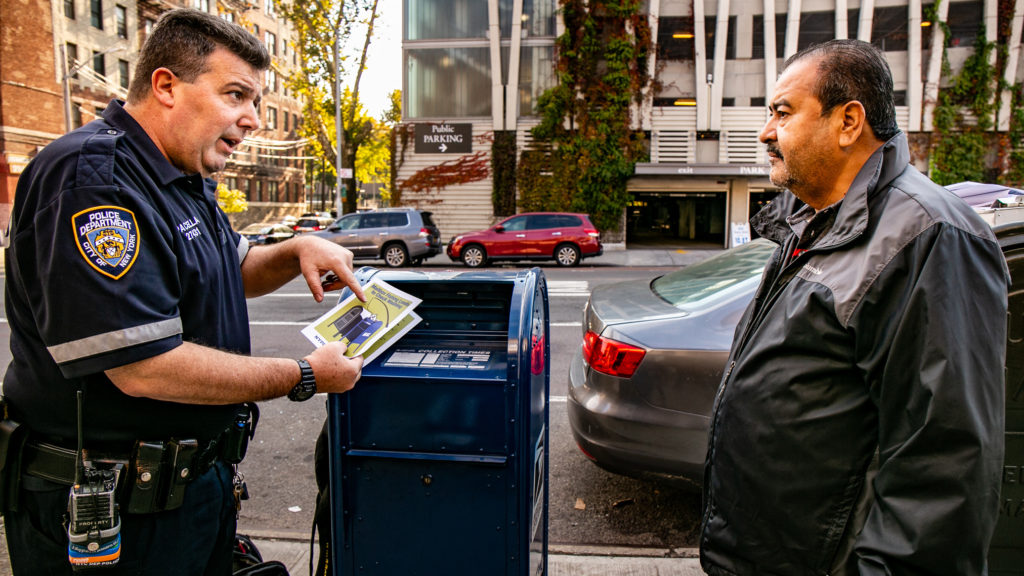
Photo by Adi Talwar
Crime Prevention Officer Frank Pacella has spent much of the last few weeks visiting at least 60 U.S. Postal Service (USPS) mailboxes within the 52nd Precinct. At each stop, Pacella pulls out a clipboard and jots down the locations of nearby security cameras he’s spotted. The initiative is the most recent step taken by the NYPD to combat mail fishing, a tactic thieves use to steal checks and commit identity fraud.
The order came down from the NYPD’s Crime Prevention Division ahead of the start of the holiday season, when rates of mailbox fishing and other mail fraud typically increase.
“A couple weeks ago we got an email from the Crime Prevention Division and it basically tasked us with going out, going to each mailbox, and just kinda checking it out and looking basically for video,” Pacella told the Norwood News. “Whether it be an [NYPD] Argus camera, whether it be a residential building, a commercial building, you know… it’s going to eliminate some of the legwork [down the road].”
By logging the owners and locations of cameras near USPS mailboxes, the NYPD hopes to expedite their investigations into these crimes. Oftentimes, even if police know which bank the check was cashed at, the bank will not turn over security footage until they are subpoenaed.
“There are certain corporations that are not police friendly. You got to get a subpoena. It’s company policy,” Pacella said. “Once that check is cashed, you have to try to get subpoena records from the bank if they have video and it takes months.”
Mailbox fishing is the practice of using glue or magnets on the end of a string to “fish” mail out of blue USPS mailboxes. Thieves then shuffle through the mail and find checks, money orders, and credit cards.
Checks found during these fishing expeditions are then altered using common household substances, like nail polish remover or rubbing alcohol, and readdressed to the thief or an accomplice. The mailbox fishers then go to a bank or a check cashing storefront to get their payoff.
“Once that check is cashed, you have to try to get subpoena records from the bank,” Pacella said. “And more than likely, if you’re smart, you get someone out on the street. ‘Hey, you want to make $20? Go cash this check.’”
Pacella believes the best shot police have at reducing the rate of these crimes is by educating Bronx residents on the risks. Pacella, an old-fashioned cop who lamented the loss of “Broken Windows” and Stop and Frisk policing at a “Build the Block” meeting at P.S. 56, openly admits he is uncomfortable with “the online” and prefers writing checks to online transactions. But that might make him the perfect man to help educate potential victims, many of whom are elderly and unfamiliar with the Internet.
“I like to just go out and look. I think it’s a good opportunity to bump into people and give them awareness of what’s going on,” Pacella said. “The elderly fall victim because they’re still writing checks. They’re not too tech-savvy as opposed to the younger generation.”
“We went to each mailbox – I’d say practically every mailbox has some sort of sticky substance,” Pacella said. “You can see remnants of the glue. It’s kind of crazy.”
Mailbox fishing became a growing focus of the NYPD and city officials in the last few years. In 2016, hundreds of mailboxes in the Bronx were removed in favor of newer models. After some delay, thousands of what Phil Bartlett, inspector in charge of the U.S. Postal Inspection Services’ (USPIS) New York Division, calls the “Cadillac of mailboxes” began to be installed across the city this spring. The new boxes replaced the opening tray with slit less than a half-inch high. Each box is also equipped with internal, anti-fishing protections.
Still, the problem persists. In July, the U.S. Attorney for the Southern District of New York announced that a ring of eight fraudsters were sentenced to various prison terms for a “long-running scheme to steal mail from Bronx mailboxes.” The eight thieves were ordered to pay $150,000 in restitution to their victims. Prosecutors said that between late 2015 and July 2018, USPIS and NYPD made over 50 arrests connected to $750,000 in stolen checks and money orders in the Bronx alone.
“I had a friend at a different agency who was sitting on a wire that they were monitoring a conversation between known gang members and one of the guys was like ‘why aren’t you guys doing this?’” Pacella said of mailbox fishing. “It’s so much easier [than other crimes]. It’s harder to get caught.”
To avoid check washing schemes and identity theft, police recommend using alternative methods of transferring money. If the only option is to mail a check, police officials say Bronx residents should drop the envelope off at the post office, hand it directly to a mail carrier, or drop it in a mailbox as close to pickup time as possible.
Even then, police recommend using pigmented ink that won’t dissolve in acetone or other solvents. Most pens specified for drawing or art use pigmented ink and can be purchased at arts and crafts stores. Police also recommend monitoring one’s bank balance and ensuring that the correct amount was cleared by the correct establishment.
Last year, the Norwood News obtained police data and mapped out 50 mailboxes in the 52nd Precinct that had been targeted by these fishing schemes. At least four of the mailboxes were targeted four times in the 15 months of data the Norwood News discovered.
“Whatever mail you’re fishing out of the mailbox, you can use it for a variety of different crimes,” Pacella said. “It all ties into identity theft and there are horror stories when it comes to identity theft.”
Editor’s Note: If you’ve been a victim of mailbox fishing, call the Norwood News at (718) 324-4998.




